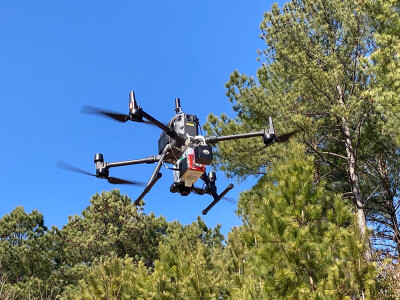Using drones for effective emergency response operations requires careful aircraft coordination between multiple operators and reliable, actionable communications. Aloft aims to improve these operations with its new Air Boss system. By offering localized low-altitude aircraft coordination and communication, Aloft believes that Air Boss is an ideal emergency response solution.
Speaking with Commercial UAV News, Greg Agvent, CEO of Windsock Aerial Decision Making and a collaborator on the Air Boss system, said “the idea behind Air Boss is to use systems that are available today, like Remote ID and UTM, then build the databases and layer information on top to create a system that can provide actionable airspace awareness to public safety agencies.”
Jon Hegranes, Aloft’s Founder and CEO, explained that Air Boss provides “operation coordination” rather than conventional “traffic management.” “There’s not a whole lot of space between those operation coordination and traffic management,” Hegranes asserted, “but what we aimed to do with Air Boss was to create a system that is cooperative and collaborative.”
To illustrate this approach, Hegranes detailed the different kinds of drones that may be flying during an emergency situation and why “operation coordination” is so important to ensure the safety and effectiveness of those flights.
“Emergencies and disaster response situations are high value opportunities where there is a lot of flight happening all of a sudden, and when first responders, utilities, and media companies converge on a location all at once, it can get pretty complicated,” he said. “With Air Boss, we can coordinate what’s going on.”
The system, he reported, gives operators access to the Aloft network, which allows them to identify themselves and manage flights in conjunction with other operators. “Air Boss lets different operators, whether they’re recreational, commercial, government, or military, raise their hand and say, ‘I'm operating here’ or a pilot can say, ‘Hey, can you move your operations or delay your takeoff for a few minutes?’”
To enable these collaborations, Air Boss “brings together multiple elements required for low-altitude UTM,” including custom data layers and live flight feeds, compliance capabilities for fleet management, UTM, and Remote ID, developer APIs and map tiles to integrate natively with emergency response centers, FAA-approved USS capabilities, such as LAANC, and secured and certified systems to ingest radar and surveillance data. Moreover, Aloft says it has “the largest audience of recreational, commercial, and government drone operators” and “over 5 million square miles of unique safety data via Aloft Geo.”
Combined, Agvent said, these elements not only help emergency response personnel, news media, healthcare providers, law enforcement, and others operate their drones safely in crowded, complicated airspace—they can foster an environment of cooperation and order in the drone world.
“For years, one of the major concerns in the drone industry has been counter-UAS and how we handle those that are non-cooperative,” Agvent said. “The Air Boss system rewards and builds on the cooperative airspace. It rewards those that are doing things the right way. The public safety agencies, the power and light folks, the inspection folks, the medical folks, the delivery folks, the news media—they're all part of infrastructure and ecosystem of cooperative aircraft. Building this cooperate airspace, I think, quite honestly, is driving expansion and growth in the entire industry at this point.”















Comments